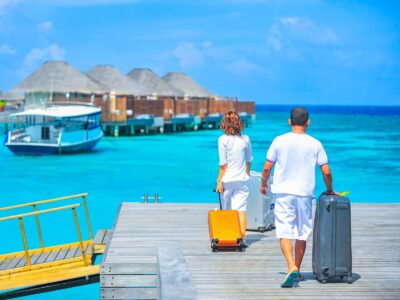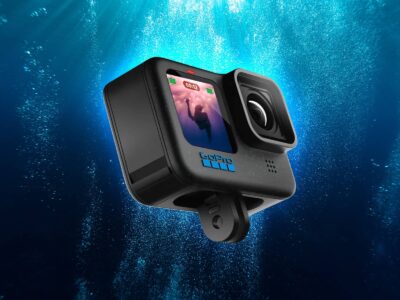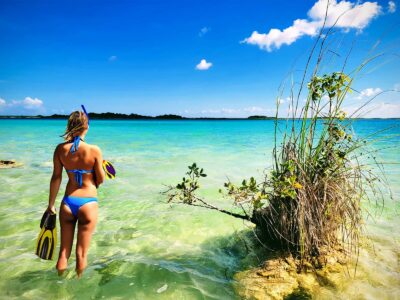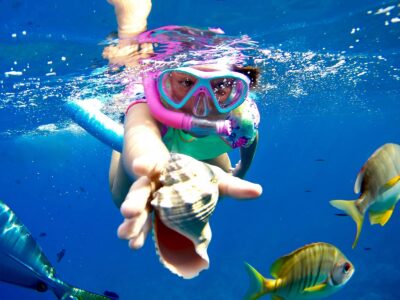For decades, there was one type of snorkel mask: a traditional snorkel mask that covered your eyes and nose. Then, pair that with a traditional snorkel which was more or less just a curved open tube that you held in your mouth, and you had everything that was available to you as a snorkeler for a long, long time.
But, snorkel technology has come a long way over the years and there are now a lot more fascinating options available that your parents or grandparents didn’t have; most notably, full-face snorkel masks and dry snorkels.
Full-face snorkel masks are a newer concept which not only cover your entire face from forehead to chin with a clear dome, but also include an integrated dry snorkel at the top of the mask with a one-way valve that keeps unwanted water from finding its way into the mask while still allowing you to breathe. They’ve really changed what we would have thought possible for snorkel masks even just a handful of years ago.
But, make no mistake, traditional snorkel masks have upped their game in recent years as well. New materials, purge valves, and sizes — not to mention dry snorkels now being available for traditional snorkel tubes — demand to be considered.
So, which is best? Let’s put full-face vs. traditional snorkel masks head to head in 6 key areas and find out.
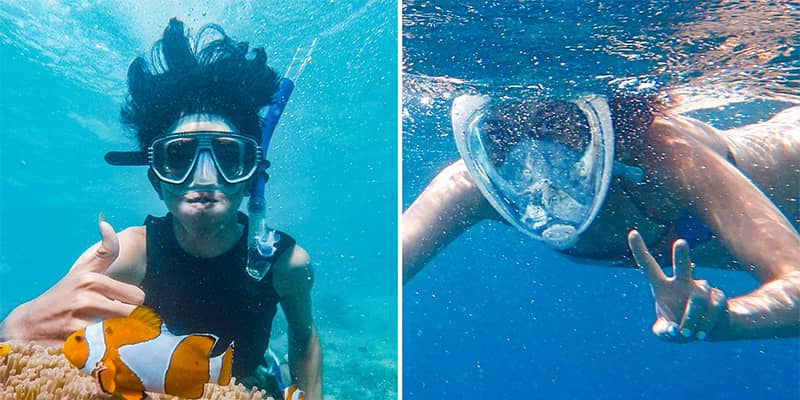
1. Safety
Traditional Snorkel Mask Safety
- Safety is understood
- Generally considered safe if you follow normal snorkel safety precautions
Full-Face Snorkel Mask Safety
- General concept should be big on safety in theory
- Not yet officially deemed safe or unsafe
- Some knock-off masks may have valve problems
- Might exacerbate existing health issues
Probably the first question we should ask about any new equipment we’ll be wearing out on the water is about how safe it is. That’s always a great question for snorkel masks, but in this case it gets a little complicated.
Full-face snorkel masks have a great safety concept in theory. The full-face dome allows you to use your nose and mouth to breathe normally and not have to worry about holding a water-tight seal on your snorkel with your mouth. And, the one-way snorkel valve built in keeps water out while you breathe normally. It’s all a wonderful idea, especially for newer snorkelers.
But, as full-face snorkel masks have gained popularity, it seems like so have some safety incidents. Is the increase because of some problem with the masks themselves? Is it just because full-face snorkel masks have allowed more people to get in the water, so any kind of number is going to be higher? Is it just a statistical anomaly?

Tons of people do have safe and fun experiences with full-face snorkel masks every day, but right now, no one knows for sure. Hawaii’s Health Department, in particular, is looking hard into full-face snorkel masks, but of yet, have not been able to find any direct association to problems outside of some people’s reports [source].
One theory about a potential problem is that the one-way valves in the dry snorkel of many of the cheaper knock-off full-face snorkel masks aren’t of great quality and may not be allowing enough CO2 to escape the mask as you exhale. That would definitely cause a problem if true, and would make it highly-important to pick a mask from a quality snorkel manufacturer with a good testing and safety record. (We continue to hear positive things about the Tribord Subea Easybreath [Amazon] and the Head by Mares Seaview [Amazon].)
Another theory, at least in one known case, is that snorkelers who have previously-existing health issues like high blood pressure may be especially at risk of complications because of the elevated breathing requirement to keep a fresh flow of air throughout the mask. [Source]
But, officially, no one knows whether any of the unexplained safety problems have anything to do with any of the full-face snorkel masks. They’re just too new. The jury’s still out, and recommendations on these may or may not change.
The question is serious enough, though, that some in the Hawaii state government have even taken to passing a resolution recommending the ban of the sale and rental of full-face snorkel masks. [Source] (Note that at time of writing, full-face snorkel masks are not illegal in Hawaii, though certain tour operators have independently banned them for their tour groups and some retailers have voluntarily stopped selling the masks.)
There’s a lot more to the story and more to consider if you’re looking into full-face snorkel masks, so if you need to know more, check out our guide on full-face snorkel masks.
With traditional snorkel mask safety, on the other hand, you more or less know what you’re getting. The form factor has been around for so long, and lots of tests and experience has gone into refining them well over time. Though they don’t have some of the benefits of full-face snorkel masks like the face dome or integrated dry snorkel, that long-term refinement and the availability of separate dry snorkels help make snorkeling considered a very safe activity so long as you follow general snorkel safety guidelines.
Safety Winner: Traditional snorkel masks. In theory, full-face snorkel masks should be able to have the higher safety marks. But, until their safety can be more verified, the tried-and-true traditional snorkels masks get the nod.
2. Visibility
Traditional Snorkel Mask Visibility
- Lens size has increased over time
- Still limited to the area around your eyes
Full-Face Snorkel Mask Visibility
- Large panoramic dome surrounding your face
- Increased periphery and general field of vision
Visibility is one area where full-face snorkel masks do really shine. Instead of a snorkel mask frame that is limited to the space around your eyes, full-face snorkel masks use kind of a panoramic bubble to surround your face, letting you see far more above and below you as well as along your periphery. It really does make a big difference.
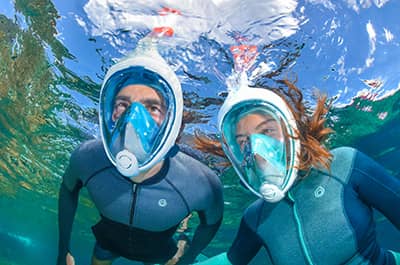
It’s not all bad with traditional snorkel mask visibility, though. Over time, snorkel mask lenses have become much larger and you can still see a lot through them. It’s rare that you would find yourself significantly limited with the visibility that traditional snorkel masks provide, but full-face masks do provide just that much more.
Visibility Winner: Full-face snorkel masks. The visibility of traditional masks have come a long way, but it’s tough to beat the panoramic dome that full-face snorkel masks provide.
3. Comfort
Traditional Snorkel Mask Comfort
- A traditional mask that fits well should be comfortable
- Holding a snorkel in your mouth for long periods of time can be tiresome
Full-Face Snorkel Mask Comfort
- A full-face mask that fits well should be comfortable
- No separate snorkel to hold in your mouth
No matter what type of snorkel mask you want to use, comfort is one of the most important considerations that you should make. You don’t want to have to just tough out a dive because your mask hurts — there’s just too much to see and do!

In both cases with the full-face snorkel mask vs. regular, every mask is going to fit you a little differently, so it’s important to give a few a try to see what works best for you. There isn’t anything about one mask concept or the other that is going to guarantee more comfort on your face, though — either it fits your face well and sits comfortably or it doesn’t.
One area where full-face snorkel masks do pull ahead, though, is with the snorkel itself. With full-face masks, the snorkel is integrated into the top of the mask so you don’t even have to think about it. With traditional masks, though, you need to hold the snorkel in your mouth and keep a tight enough seal around it with your lips so that water doesn’t seep in. This isn’t usually very difficult, but it is a bit of extra effort and can cause a little bit of jaw or face fatigue if you snorkel for long periods of time.
Comfort Winner: Full-face snorkel masks. Ultimately, you’re going to need to find the specific mask that fits your face best, but the lack of a snorkel to hold in your mouth makes full-face snorkel masks more comfortable to wear overall.
4. Keeping Water Out
Traditional Snorkel Mask Keeping Water Out
- A well-fitting traditional mask should be water-tight
Full-Face Snorkel Mask Keeping Water Out
- A well-fitting full-face mask should also be water-tight
The second most important function of a snorkel mask (behind making sure you can see while in the water) is keeping water out, so we obviously want the best option.
The ability of a snorkel mask to keep water out is most closely related to how the mask fits you (similarly to how comfortable a mask is), though. Certain price points and quality levels of masks might have softer or more form-fitting materials, but ultimately the real test is going to be how well it fits with your own unique face.
Keeping Water Out Winner: Tie. Just be sure to try on a few masks and find the one that fits you best. Ultimately, a well-fitting mask is going to keep more water out.
5. Diving
Traditional Snorkel Mask Diving
- Diving underwater is a common, fun pastime
- Equipment does not make it more difficult to dive
Full-Face Snorkel Mask Diving
- Diving underwater is possible, but difficult
- Extra air trapped in face dome adds significant buoyancy
As you start to become a more advanced snorkeler, one of the coolest things you can learn to do is dive underwater with your snorkel gear to get a closer look at whatever you can see from above or even to swim alongside marine life that doesn’t always hang out at the surface. It can really make for some incredible experiences.
(If you want to learn how to snorkel underwater, check out our guide as an excellent starting point.)
Diving underwater has been a part of snorkeling as long as snorkeling has existed, which means that traditional snorkel masks work well for it. Basically, hold your breath and dive.
But, full-face snorkel masks make diving a lot more difficult. Because of the much larger dome around your face, more air gets trapped inside which adds a decent amount of buoyancy. This is actually kind of nice if you don’t have any intention of diving underwater because it makes snorkel flotation easier, but it’s enough buoyancy that it makes it notably tougher to dive underwater should you want to.
Diving Winner: Traditional snorkel masks. When you want to take your gear underwater, traditional snorkel masks will give you much less resistance than with the extra buoyant air trapped in full-face snorkel masks.

6. Price
Traditional Snorkel Mask Price
- Prices are reasonable
- Diversity of price points for different levels of equipment
Full-Face Snorkel Mask Price
- Prices are still reasonable
- Should probably limit search only to certain masks
- Tend to be more expensive among beginner equipment
Snorkeling, fortunately, is a very inexpensive sport, especially when comparing snorkeling vs. scuba diving, so nothing with either full-face snorkel masks vs. traditional are going to break the bank. And, something like a snorkel mask to call your own can really make any trip to a coast much more memorable since it will allow you to snorkel more, whenever and whenever you want. The investment is totally worthwhile.
That said, there are some price differences when comparing full-face vs. traditional snorkel masks.
As we discussed in the safety section, you really only want to look at full-face snorkel masks from established snorkel mask manufacturers with good safety records. Two masks that we get that kind of good feedback about are the Tribord Subea Easybreath [Amazon] and the Head by Mares Seaview [Amazon], which usually go for around $90 and $80, respectively. So, that’s about the price point you’ll find yourself at with full-face snorkel masks.

Traditional snorkel masks (and snorkels), on the other hand, have a lot more price variance. The safety factor should be pretty similar across any decent traditional snorkel mask, and you instead just pay more or less for quality or performance.
It’s definitely possible to pick up a solid beginner snorkel mask for $30 (our favorite is the Cressi F1 [Amazon]) with a nice dry snorkel for $20 (we like the Cressi Supernova Dry [Amazon]). But, if you want excellent gear, our picks for the best top-end snorkel mask and dry snorkel overall are the Atomic Venom Frameless [Amazon], which runs $170 right now, and the Oceanic Ultra-Dry 2 [Amazon], which should be about $60. And, you have plenty of options everywhere in between these lower and upper levels, which is always a plus.
Price Winner: Traditional snorkel masks. You’ll find a lot more flexibility and price points among traditional snorkel masks and snorkels, whereas with full-face snorkel masks you should only consider name brand masks with good safety records which tend to be a little more expensive for beginner snorkel gear.
The Best Traditional Snorkel Mask
As we mentioned, there’s a ton of variability in the type of snorkel masks which you can pick up today, and it even further depends on your skill level, the number of times you’ll be snorkeling this year, budget, and other factors.
To help you sort all of this out and find the right mask for you, you can read our helpful guide on the best snorkel mask for all skill types, budgets, etc.
If you’re also curious about the best snorkels that money (or a specific budget) can buy, we also have a full guide on the best dry snorkels out there. (We typically only recommend dry snorkels vs. traditional open/wet snorkels because they’re so much safer for nearly everyone.)
Finally, if you’re interested in zeroing in on the right snorkel gear for you beyond the typical mask and snorkel, head over to our big rundown on the best snorkel gear (masks, snorkels, fins, bags, underwater cameras, and plenty else).
The Best Full-Face Snorkel Mask
If you’re really feeling set on a full-face snorkel mask and the unclear safety concerns aren’t a problem for you, we still recommend being discerning with your full-face snorkel mask choice and limiting your selection to a mask from a snorkel manufacturer that has a good safety record and has put their masks through a lot of safety tests.
So, in the name of figuring out how to tell if a mask falls in this category, we also have a companion guide on the best full-face snorkel masks with more background on safety and choosing a mask.
The Deep Dive
Traditional Snorkel Masks
- Positive safety record
- Can be water-tight with a good fit
- Best option for diving underwater
- Reasonably priced
- More flexible prices
- Holding a separate snorkel in your mouth can be a little tiring
- Somewhat limited visibility
Full-Face Snorkel Masks
- Amazing visibility
- No separate snorkel to hold
- Can be water-tight with a good fit
- Reasonably priced
- More difficult to dive underwater
- Should probably be limited to only a handful of options
- Some unknown safety questions yet to be answered
Snorkel mask technology has changed a lot over the years and you are no longer limited to only one type of mask or snorkel. Should you want to branch out from traditional snorkel masks, which have improved a ton over time in their own right, you now also have full-face snorkel masks as an option.
Both full-face vs. traditional snorkel masks have a lot to offer, and each has their own sets of benefits, trade-offs and price points. But, which is best when it comes to full-face vs. traditional snorkel masks?
Some of the answer may end up depending on when and how any potential safety questions with full-face snorkel masks are answered in the future (keep an eye out for new info out there), but otherwise there isn’t necessarily a clear-cut winner for every person. Ultimately, it should instead depend on your preferences when it comes to safety, visibility, comfort, keeping water our, diving and their price points.
Up Next
Now that you’ve (maybe) decided what type of snorkel gear you’re into, check out our guides on how to find the right gear for you below:






